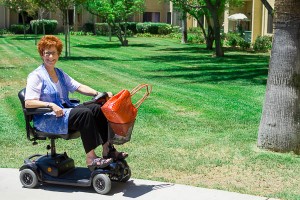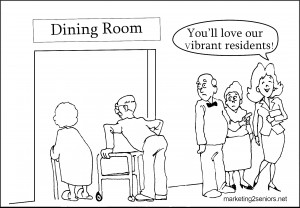by Diane Masson | Jul 27, 2014
A broken toe and a scheduled photo shoot at a retirement community does not go well together. As I was hobbling around, trying to tough it out, the pain intensified. I needed a “plan b”. It was my lucky day, because the wonderful resident I called for a favor had a second motorized wheelchair. So he let me borrow his electric cart. Electric carts are fun to drive like a speed demon down the hall, but the reality of using one can quickly set in. I had to navigate a photo shoot on several different floors in tight spaces. Some of the photo scenes were in the dining room and the arms of the electric cart seemed to reach out and grab tablecloths. Then the neatly placed silverware would become disheveled. At each mishap, I took the time to restore the silverware to its original placement. It was lucky that I could stand on one foot to accomplish this. When I pulled the cart up to my office, off the lobby, it was so much easier to leave it by the door so I could limp in. Then my mind starting remembering all the times I had complained about residents leaving their carts in the lobby when they went on trips. If you can’t walk, how can you park your cart in an inconspicuous location and hobble to the bus? It’s impossible. Elevators were an experience too. I am able bodied, but residents using electric carts are not as flexible. I had to really stretch to reach the elevator button. When I rolled onto the elevator, I had to...
by Diane Masson | Jul 20, 2014
I was a sucker to think it would be fun for my husband and I to go on a timeshare presentation at the Lawrence Welk Resort. My Auntie watched Lawrence Welk every week when I was little. It was supposed to be a fabulous place and seniors from two of my Continuing Care Retirement Communities go there regularly for performances. Our promised gift for participating in a 90 presentation was going to a trip for two to Catalina Island. Well here are the 12 sales no no’s that happened: Promising that the appointment would be 90 minutes and then almost doubling the time. Asking us to arrive early and then making us wait. Pushing a person for personal information in a non-genuine or unnatural manner. (This is so uncomfortable!) Not listening! Giving a canned speech with a pitch type voice. Sharing long boring stories and wasting our time. Giving a promise that the company cannot fulfill. After not listening, asking a closing question, when there was nothing to close on. (This is so wrong!) Failing to give us the promised gift. Lying. Trapping us in several closing sequences, because a golf cart was required to return us to our far off parking spot. Making me feel like a number. The appointment was almost three hours instead of the promised 90 minutes. They persisted in a quest for our personal information (very awkward) without sharing the facts of their offering in a timely fashion. They absolutely never listened and it was all a canned speech. The worst is having someone try to close you, when there is zero interest. You...
by Diane Masson | Jul 13, 2014
A younger senior woman with long hair and beads asked me this question at a presentation last week. I asked what a hippie retirement community would look like for her. She said, “Less walls and more indoor and outdoor living. Where you felt outdoors, even when you were indoors.” This made me think about our outdoor dining venues, so I showed her the “Fountain Café at The Village.” It is an outdoor dining venue, where the chef barbeques for the residents. Entrée choices might be barbequed salmon, ribs or an amazing burger. Soft music emits from rock speakers that reside in the surrounding garden. Residents can come and sit in the outdoor café at any time to read a book or spend time with visiting family. Beyond the Fountain Café area is the popular putting green. She loved the outdoor area. I said, “Is this what you are talking about?” She said, “Yes!” Then I explained how the health club with state-of-the-art exercise equipment adjoined the outdoor swimming pool. It has an indoor/outdoor feeling too. The younger senior loved it and agreed, but said she was not ready for an apartment with walls. Anyone know of a hippie retirement community, maybe something with tents? Are we ready for Boomer hippies? Can you share what is happening in your city and state, so we can all understand senior housing from a national perspective? It’s as easy as making a comment below. Thanks in advance for joining the conversation and sharing this blog with other professionals in the senior living world. Diane Twohy Masson is currently writing a new book for...
by Diane Masson | Jul 6, 2014
How many move-ins have you produced in the last 12 months? Are you staying ahead of the move outs? There seems to be a heavy attrition in all levels of senior living from independent living, assisted living and skilled nursing care. Is this what you are currently experiencing in your city? Older and frailer residents are moving into all levels of care. They stay for a shorter amount of time. As a regional marketing director at two Continuing Care Retirement Communities in CA, I have experienced new independent residents move through three levels of care in less than a year and expire. At the same time, I am seeing a new wave of younger senior couples moving into our communities. Maybe the senior housing industry has turned a page since 2008? Since that epic stock market drop, seniors moving in their 70’s and low 80’s had literally evaporated. Have you witnessed a come back of younger seniors moving into your retirement community or not? Can you share what is happening in your city and state, so we can all understand senior housing from a national perspective? It’s as easy as making a comment below. Thanks in advance for joining the conversation and sharing this blog with other professionals in the senior living world. Diane Twohy Masson is currently writing a new book for seniors on how to select senior housing options. Her first book, “Senior Housing Marketing – How to Increase Your Occupancy and Stay Full,” is available at Amazon.com with a five star rating. Masson continues to set move in records as the regional marketing director of two debt-free...
by Diane Masson | Jun 29, 2014
Every senior living lead should have a short-term and long-term strategy. An initial call-in goal is to get a senior living prospect to come to your building for either a tour or an event. You should create short and long-term goals for each walk-in prospective resident too. Here are 10 walk-in tour goals with number one being the highest level to achieve: The highest level is having the senior move into your senior living community. Way to go! You helped them find a solution for their needs. Scheduling a move-in date – this means their house sold and they are ready to move in now. Depositing on an apartment – congrats it is a sale! Coming back to choose an apartment – don’t make any assumptions or they will walk away without selecting an apartment. Coming back to discuss financial requirements – it helps to have the administrator involved. It is always humorous for someone with one million dollars to wonder if they can afford your community. Coming back to discuss health concerns – this may or may not be the official health assessment. I have had seniors with arthritis wonder if they will qualify. Coming back to dine with residents – this is usually encouraged by you the sales person. Let your resident’s magic work on your prospect. Attending an event – let them imagine the lifestyle of your community. Touring a second time – invite them back to dine, look at the perfect apartment or meet some residents/staff. Wanting to ask more questions – this is fantastic, it means they are interested. Help them find a solution...
by Diane Masson | Jun 22, 2014
The prospect may say, “I want to think about it.” “I am one or two years away.” “I am not ready yet.” “I am not interested in a pushy salesperson.” Will you still call them back promptly the next day? If not, why not?? The senior living prospect walked in your door for a reason. They need your services or are considering your services. They should automatically be classified as warm if they walked into your senior living community. They may be eating cereal for dinner or sleeping in a recliner chair because the alternatives are too much effort. This is a viable lead that deserves your time and attention, even if they say, “I am not ready yet.” I find it appalling that some senior living sales people will only give the time of day to a senior that can move in now. Ultimately, they are neglecting potential sales. In my experience, only 25% of the seniors say, “I am ready now.” “My home is on the market.” “My kids say I have to move immediately.” “My doctor recommends that I move to assisted living right away.” So this means that the other 75% of potential seniors are too scared to express their needs. They say a quick statement in the beginning to protect themselves from being SOLD by you. They have lived in their home for 40 or 50 years. They don’t WANT to move. They are just beginning to UNDERSTAND that a move would be beneficial to their health and well-being. Educate this scared senior and show how your Retirement Community, Assisted Living or Continuing Care...
by Diane Masson | Jun 15, 2014
Do you know what is on the mind of your sales people? Is it finding a solution for the senior calling in or walking into your retirement community top of mind? Or is it on the latest text from their spouse or child? Statistics say that a significant portion of your staff is not engaged with their work. Ugg!! Are personal issues shared every morning over coffee? Why? Can this help the occupancy of your senior living community? No! What it does create is a negative atmosphere to start the day. Senior living sales people receive continual rejection on the phone and closing sales. It is key for them to have a great attitude and be fully engaged with each prospective resident. Negative office politics can suck a sales person’s energy and enthusiasm. Do you need help turning your retirement community’s attitude around? Chapter one of Senior Housing Marketing – How To Increase Your Occupancy and Stay Full is chock-full of tips for sales people to improve their attitude and keep their energy up. Your tips could help others improve on a national basis, so please share by commenting on this blog. If this weekly blog can help your sales and occupancy – why not invite your team to sign up today so no one misses a single tip to improve the occupancy? Diane Twohy Masson writes this weekly blog to support and engage with other senior housing professionals. Her first book is Senior Housing Marketing – How To Increase Your Occupancy and Stay Full. Many sales teams and organizations have used the 12 keys contained in this book...
by Diane Masson | Jun 8, 2014
There are thousands of senior living sales people across this country. After each tour, they have choice to pursue a viable lead or simply ignore it. Is your frontline sales staff making the right decision? Do you review new inquiry leads with them? If not, why not?!!? It costs your senior living organization thousands of dollars to bring in new call-in leads and walk-in tours. Just this last week, I know of two sales people who each blew off a lead because it was not quick move-in. Luckily I caught them in time, so that follow up phone calls could happen. One prospective resident couple had a complicated situation with a wife who wanted independent living with a husband who was qualified for skilled nursing care. They wanted to bring in their own caregiver and the man could not feed himself. The sales person felt it was too complicated to pursue. I shared a story of a couple that came to my Continuing Care Retirement Community several years ago. The man was dying and the couple wanted to move to independent living together. My executive director said no, it was too hard on the other residents and he was not independent. In spite of this decision, I loved on this couple. Five months later, the husband died. I sent sympathy card. The wife appreciated me reaching out with caring kindness. Within weeks, she moved into my retirement community. So when the senior living sales person called back this complicated prospective resident couple, he learned that the husband was in the hospital. He loved on the wife as I had...
by Diane Masson | Jun 1, 2014
Yesterday, I learned of a senior resident in California who was denied HER long-term care coverage in skilled nursing, because she had missed one payment while ill. Are you seriously kidding me? This is flat out wrong and it makes me angry. I have been in the senior living industry for fifteen years and always considered those with long-term insurance fortunate. Now I realize that when a senior is most vulnerable is also when they need this coverage to kick in. Who will fill out the paperwork? All the Continuing Care Retirement Communities where I work graciously accommodate residents in this area. But what about missing a payment to the long term care insurance company? This seems bound to happen. According the Alzheimer’s Association one in three seniors die of dementia, so it would make sense that a senior with dementia or Alzheimer’s might miss a bill or two. So all those years of paying in for a higher level of care are negated when you are sick and demented? Come on, this is not acceptable. Long-term care insurance is a security blanket to offset the high cost of future health care as you age. Many seniors have paid in for years to either have a policy that provides up to a certain dollar amount or certain time range (typically three years). The senior and her family are all panicked. The son made numerous attempts to call his mom’s insurance company and would remain on hold for over forty minutes. Unbelievably, after he finally reached them thirty days later, the policy had expired two days before for lack of...
by Diane Masson | May 25, 2014
Sounds simple – right? It’s all the companies that provide the same services that you do. Wrong! It is so much more than your similar competitors down the street or in your particular industry. Let’s just use the example of your front desk/concierge/greeter/receptionist. Whether you are in the hotel business, retail trade or provide senior housing, each customer compares how he or she is treated when they enter your establishment. So Wal-Mart, The Ritz-Carlton and a Continuing Care Retirement Community are competing. Customers may call two or three different types of companies in a single day. Each phone call either provided a great phone interaction and a solution for the customer or some frustration. Maybe they called to make dinner reservations, a doctor appointment or inquired about their parent’s future care at an assisted living community. How many rings did it take for someone to answer the phone? Was their voice clear, distinct and friendly? Did it sound like they were smiling through the phone or a bit haggard? A FedEx delivery from an online store, a pizza delivery, a taxi transporting someone to the airport and a driver from a retirement community taking a senior to and from a doctor checkup are all competition. Was the delivery person friendly and were they on time? Did they leave the package in the rain or was the pizza cold? Take time to work with you team on how you can provide better customer service. Can you think of more examples of competitors who don’t initially seem like competitors? Please feel free to sign up for my weekly blog. Diane Twohy...
by Diane Masson | May 18, 2014
Are you just going through the motions and showing your senior living community? What’s something you can do to jump out from all the competition? How about a power statement at the beginning of your tour or presentation? Let me throw down a few power statement ideas and then you can share yours on the comment area of this blog. Hopefully, everyone will help each other tweak their power statements to make them stronger. “A lot of seniors are excited about moving in here. We have 15 people moving into 10 apartments in the next two months. There is so much interest in our retirement community right now that we have limited availability.” “One of our caregivers just won caregiver of the year.” “Our chef just won an iron chef competition.” “SB Hospital just told us they are proud to partner with us. We are now the cornerstone and long-term care pillar in our community, because all the other local administrators and director of nurses have changed many times. We alone remain constant in key staff longevity and great care management.” Now, it is your turn. Time to share your power statement and we can either give you a “like” or make a suggestion to enhance your statement further. Any suggestions to tweak mine? A special shout out to Nona for writing this comment to me last week, “Each time I read one of your blogs I become a more skilled senior sales professional. I love the attitude meter. Thank you for your enthusiasm and insights.” Please feel free to sign up for my weekly blog. Diane Twohy Masson...
by Diane Masson | May 11, 2014
After a senior has been diagnosed with a progressive disease such as macular degeneration of the eyes, the onset of blindness, dementia, brain tumor, stroke, cancer, etc. – one of two things can happen: The senior gets their affairs in order and prepares for someone to care for them when they no longer can. They go into denial. As a senior’s disease progresses they may come and tour at your community or mine. It is very difficult to know that this senior may be in an unsafe situation in his or her home. I think it affects each of us who are caring professionals in the senior housing industry. Yet, the senior refuses to bring in help to their home or move to retirement or assisted living community. It becomes even harder when the adult children are extremely worried. They may be begging you to talk his or her parent into moving into your senior living community. I believe the biggest reason this type of senior does nothing is because they are only living in the moment instead of recognizing the potential hazards of their health deteriorating further. What can we do to unfreeze seniors who may be at risk? Ask great questions Find out why they decided to tour your community today Inquire about what is most important for them Help them recognize they have a challenge Try to have them vocalize their plan for when they can no longer take care of themselves Educate them on potential future outcomes As a professional senior living expert, who has the best interests of the senior at heart, what have...


















